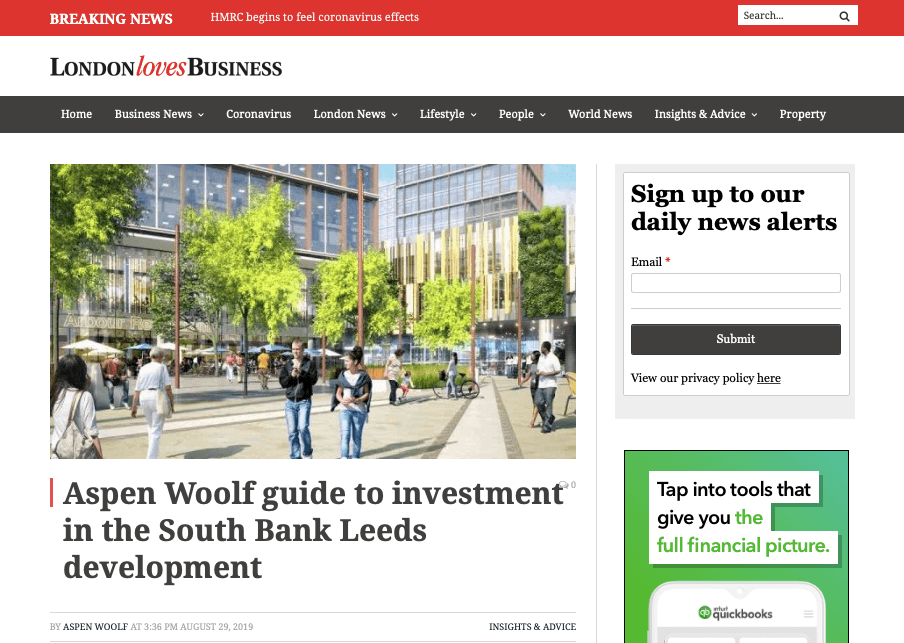Aspen Woolf guide to investment in the South Bank Leeds development

In the latest of a series of city property investment guides, the experts at Aspen Woolf explore why South Bank Leeds is exciting investors.
For the last few years investment focus has focused on the cities of Liverpool and Manchester, with Leeds remaining somewhat in the shadows. Thanks to one of the biggest regeneration projects in Europe, aimed at doubling the size of the city centre, Leeds is about to take the limelight. The South Bank Leeds development is a truly transformative project that will change the face of a city that’s undergoing the biggest development for more than a century. It’s also packed with investment opportunities.
What is the South Bank Leeds development?
South Bank Leeds is an area of 253 hectares situated just south of the River Aire. It is the scene of a huge regeneration project that will completely revolutionise the area and the very identity of the city.
As part of the overarching development there are many ambitious investments proposed for the space. The area is the size of 350 football pitches and will be transformed into a ‘globally distinctive’ destination for living, learning, creativity, leisure and investment. According to the South Bank Leeds Regeneration Framework Supplementary Planning Document (SPD), there will be more than 8,000 new homes and 35,000 new jobs as part of this landmark regeneration project.
Strong economic centre
South Bank Leeds has long been home to multinational companies, including ASDA Walmart’s European headquarters and SKY. There are also more than 3,000 people currently living in the area, and a sector comprising more than 250 businesses.
South Bank Leeds showcases diversity and innovation and boasts several sectors that already contribute hugely towards the Leeds economy. This regeneration project will make an already powerful area even more prosperous. The aim of the project is to attract skilled workers, create more jobs and land investment from all around the world by improving infrastructure, transport links and more.
Improving accessibility and infrastructure
Leeds is already an extremely accessible city, with strong transport links to London and the rest of the country. What might be the most significant change to transportation in the country will have a potentially massive impact on Leeds. The South Bank area is earmarked for the new HS2 station, which will merge with Leeds train station. This will mean a facility that welcomes more passengers than Gatwick airport, and it will have an enormous effect on connecting the city to the rest of the country. It is estimated that by 2050, 40,000 new jobs will be created and a £54 billion boost will be given to the regional economy, thanks to HS2.
Other infrastructure developments proposed within the regeneration plan include transforming the city’s roads, improving the network of highways and boosting flood protection. There will also be plenty of new public spaces, super-fast broadband and plans include creating a robust, future-proof social infrastructure aimed at supporting residential developments.
The project will also place the River Aire firmly at the centre of the city. By reintroducing this river into people’s lives, it will become a part of a new, green network. People will be able to freely walk along the riverbank as it morphs into a family destination for leisure activities.
Bringing the past into the future
South Bank Leeds is a historic area housing abandoned buildings and old warehouses – echoes of the city’s industrial heritage. By 1820, Holbeck was at the heart of the Industrial Revolution as part of the city’s flax-spinning industry. This industrial area boasted a strong, enduring sense of community, and the South Bank Leeds project aims to reconnect these historic suburbs with Leeds City Centre once again, creating a harmonious whole. The project to transform these buildings into their 21st century equivalent is already well underway.
At the heart of the development, a brand-new skyscraper will transform the city’s skyline. Forty storeys high and 142 metres tall, it will take the mantel of tallest building in Leeds from Bridgewater Place.
Plans have also been submitted to build 928 new residential properties in a sub-project called X1. The houses will be built on the old Evans Halshaw site off the A61, at a cost of more than £200 million. Comprising five separate buildings, each equipped with individual gyms and gardens, the development will also boast cafes, restaurants, offices and shops.
City living will be more in demand than ever, thanks to various developments within the South Bank Leeds area.
Leeds house prices set to soar
The South Bank area of Leeds is one of the runaway success stories in the economic growth of the city. It’s right in the centre of the booming city centre economy, and employment is set to increase over the next few years. Recent figures show that house prices in Leeds are set to increase by 17.1% by 2023, knocking Manchester (predicted a growth of 16.5%) and Liverpool (15.9%) into second and third place in terms of investment hotspots in the north.
Leeds City Centre is a hub for business and is home to the highest density of employment in the region. There is more than 600,000 square feet of prime office space under construction in the area. And South Bank Leeds will further extend the reach of this booming central area.
South Bank Leeds offers profitable investment opportunities for landlords, property owners and entrepreneurs. Rental yields in Leeds are much higher than in the struggling south east. This project offers tangible, real-world opportunities for investors who want to be a part of the exciting future of this city and see their money work for them. Leeds is set to become the heart of the Northern Powerhouse, investors will be keen to get in ahead of the curve.

